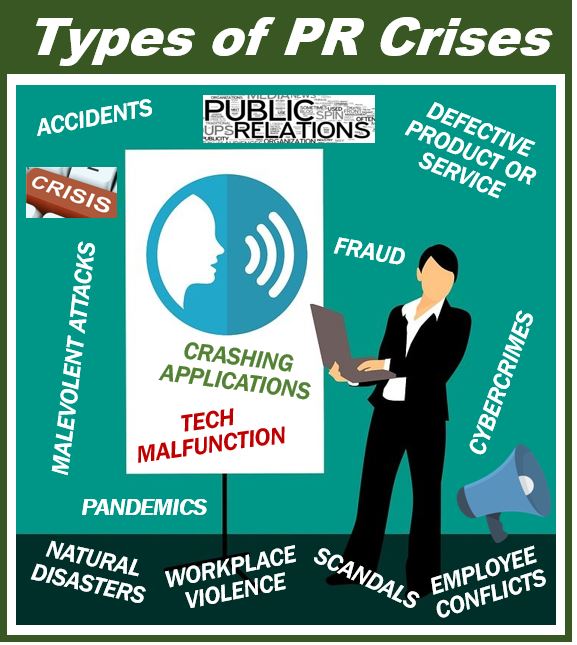A company may tread into troubled waters by making errors in various areas of the business. Failing to garner enough inventory to cater to the demand is an example of operational error. A marketing representative may shoot an insensitive reply to a customer’s complaint or post an ad campaign offending a certain population segment. The irresponsibility of the marketing personnel may lead to a PR crisis.
Major Types of PR Crises

1. Accidents and Natural Disasters
Plant fires, terrorist activities, explosions, vehicle crashes, disease outbreaks, or any other type of natural or man-made catastrophes that harm human lives belong to the category of accidents and disasters. The company may either bear full responsibility or accept no-fault under such situations.
2. Product, Service, or Staff Mess
Problems like a defective product, service, or those caused by employees fall under this category. This type of organizational crisis includes deceiving customers for benefiting the company. Employees fighting among themselves is also a part of this mess, leading to workplace violence risk.
3. Scandals
Shocking revelations about a company’s senior manager or executive involved in sexual activities, accounting mischief, and safety practices are included in this category. They might also bring under their ambit the personal life of the said employee.
4. Malevolent Attacks
Public discontent, actions initiated by regulators or competitors may cause a massive crisis to your firm. The intention to tamper with the image of a company may lead the opponents or anyone who has a grievance to hack the company’s systems, illegally use the products or damage the products to cause harm.
5. Technological Issues
The crashing of applications or malfunctioning of technology is worrisome and can cause a company to face a severe PR crisis. Software companies and e-commerce sites lose potential leads and revenue, and along with it, the reputation they had garnered over the years.
Stages of Crisis
Before zeroing in on a crisis management approach, it is essential to understand the phases of a crisis.
- Warning – Companies lookout for signs. However, one cannot always forecast when or how a crisis can occur. These signs may pertain to weather patterns, employee behavior, or company finances.
- Assessing risk – Key players in a business prepare for the worst scenario as the crisis gains visibility. This is when they assess the situation’s hold on the stakeholders.
- Responding – After reviewing the extent of risk, the business decides on the crisis management plan. During this time, it informs the customers and employees about the situation.
- Managing – The resources assigned to rectify the crisis work on the resolution plan, the event’s effects, and any new or worse effects that may emerge.
- Resolving – During this stage, most of the crisis comes under control, and the plans to get the business back to normalcy are initiated.
- Recovering – The business slowly gets back on track with the help of resolution plans.
Types of Crisis Management

A business should try to work through a crisis and take the necessary steps. Mentioned below are some standard crisis management processes.
1. Responsive Crisis Management
A crisis cannot be handled without keeping a plan of action ready for the situation at hand. In responsive crisis management, the experts execute the plan and take care of unexpected obstructions that may arise. This type of management is displayed to tackle personnel and financial crises where providing a timely response is imperative.
Companies may create a plan to inform all the stakeholders or adopt solutions to encounter the crisis.
2. Proactive Crisis Management
A business can be proactive when it anticipates a possible crisis and already plans to stop it or prepare to combat it. Though it is true that trying to prevent or plan ahead of a situation is not possible at all times, monitoring threats to the company can help it to check the impact of a potential crisis.
For example, companies having offices in earthquake-prone areas have buildings resistant to the shock and train their employees by sharing an evacuation plan.
3. Recovery Crisis Management
At times, companies do not see the crisis coming and realize it when it is very late. Sometimes, personnel and technological crises can blindside a business, giving rise to long-lasting negative impact. The company can salvage what is left of the situation. It can issue a public apology and investigate what led to the unexpected problems.
No company expects a PR crisis but has to be prepared to face one. By understanding the types of crises, the phases, and crisis management types, businesses can insulate themselves from the negative reputation and move past the event.
Interesting related article: “What does Public Relations means?”

